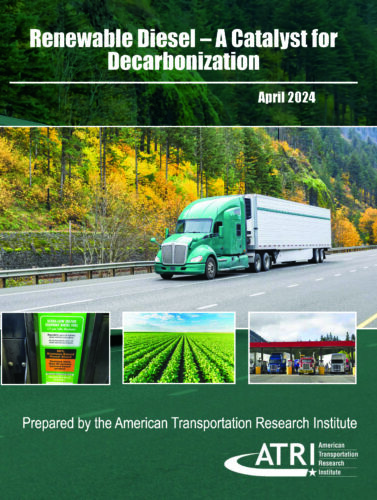New ATRI Research Evaluates Renewable Diesel as an Alternative Pathway to Decarbonization
While both RD and BEV pathways have implementation costs, the report concludes that relying on BEV to decrease CO2 emissions is nearly six times more expensive than using RD
The American Transportation Research Institute (ATRI) released a new report that analyzes the benefits of employing renewable diesel (RD) as an alternative to battery electric vehicle (BEV) trucks.
This analysis is a follow-up to findings from past ATRI research on the topics of zero-emission vehicles and electric infrastructure challenges. In those past reports, ATRI utilized the U.S. Department of Energy’s GREET Model to confirm renewable diesel as a promising solution for lowering the trucking industry’s CO2 emissions.
While both RD and BEV pathways have implementation costs, the report concludes that relying on BEV to decrease CO2 emissions is nearly six times more expensive than using RD.
In the report, RD and BEV pathways are evaluated on three criteria:
- Environmental Benefits
- Operational Capabilities
- Financial Viability
It was confirmed that when trucks using RD today are converted to BEV, there is a significant negative environmental impact. Additionally, the report highlights operational benefits for trucking when using RD as an alternative, as well as significant infrastructure and new vehicle cost savings.
“My company quickly and successfully transitioned to renewable diesel in April of last year. ATRI’s research offers concrete evidence that this move is better for the environment and easier to achieve than other low-carbon options,” said Andy Owens, CEO and Manager of A&M Transport of Glendale, Oregon.
Overall, ATRI estimated that a transition to BEV for long-haul trucking will cost over $1 trillion in electric infrastructure and vehicle purchase costs over 15 years. However, to achieve similar CO2 benefits with RD, ATRI estimates a price tag of $203 billion, a significant cost savings for achieving the same environmental benefits. Since RD is considerably more scalable than BEV and can be deployed immediately in trucks without modifications, it is likely that CO2 benefits using RD can be achieved on a much shorter timeline than with a BEV transition.
A copy of the full report is available through ATRI’s website here.
Category: Electric Vehicles, Engines & Drivetrains, Equipment, Featured, Fleet Diagnostics & Software, Fleet Maintenance, Fuel & Oil, General Update, Green, News, Shop Stuff, Tech Talk











